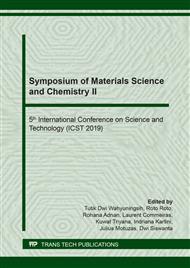[1]
Anonim, World malaria report 2018, World Health Organization, Geneva, (2018).
Google Scholar
[2]
Anonim, Data dan informasi profil kesehatan Indonesia 2018, Kementerian Kesehatan Republik Indonesia, Jakarta, (2019) 1-7.
Google Scholar
[3]
W. Kunico, C.A. Cechinel, H.G. Bonacorso, M.A.P. Martins, N. Zanatta, M.V.N. De Souza, I.O. Freitas, R.P.P. Soraes, A. Krettli, Antimalarial activity of 4-(5-trifluoromethyl-1H-pyrazol-yl)-chloroquine analogues, Bioorg. Med. Chem, Lett. 16 (2006) 649-653.
DOI: 10.1016/j.bmcl.2005.10.033
Google Scholar
[4]
N. Ebadi, Pharmacodynamic basis of herbal medicine, CRC Press, London, (2002).
Google Scholar
[5]
V.K. Bhasin, L. Nair, Act now with caution for malaria treatments, lancet. Infect. Dis. 3 (2003) 609.
DOI: 10.1016/s1473-3099(03)00767-9
Google Scholar
[6]
T.N.C. Wells, R.H. van Huijsduijen, W.C.V. Voorhis, Malaria medicines: a glass half full?, Nat. Rev. Drug. Discov. 14 (2015) 424-442.
DOI: 10.1038/nrd4573
Google Scholar
[7]
M.P. Girard, Z.H. Reed, M. Friede, M.P. Kieny, A review of human vaccine research and development: malaria, Vaccine 25 (2007) 1567-1580.
DOI: 10.1016/j.vaccine.2006.09.074
Google Scholar
[8]
A. Kumar, D. Paliwal, D. Saini, A. Thakur, S. Aggarwal, D. Kaushik, A comprehensive review on synthetic approach for antimalarial agent, Eur. J. Med. Chem. 85, (2014) 147-178.
DOI: 10.1016/j.ejmech.2014.07.084
Google Scholar
[9]
V. Gayam, S Ravi, Cinnamoylated chloroquine analogues: a new structural class of antimalarial agents, Eur. J. Med. Chem. 135 (2017) 382-391.
DOI: 10.1016/j.ejmech.2017.04.063
Google Scholar
[10]
P.N. Kalaria, S. Karad, D.K. Raval, A review on diverse heterocyclic compound as the privileged scaffolds in antimalarial drug discovery, Eur. J. Med. Chem. 158 (2018) 917-938.
DOI: 10.1016/j.ejmech.2018.08.040
Google Scholar
[11]
M. Mishra, V.K. Mishra, V. Kashaw, A.K. Iyer, S.K. Kashaw, Comprehensive review on various strategies for antimalarial drug discovery. Eur. J. Med. Chem. 125 (2017) 1300-1320.
DOI: 10.1016/j.ejmech.2016.11.025
Google Scholar
[12]
J.R. Fuchs, B. Pandit, D. Bhasin, J.P. Etter, N. Regan, D. Abdelhamid, C. Li, J. Lin, P.K. Li, Structure-activity relationship studies of curcumin analogues, Bioorg. Med. Chem. Lett. 19 (2009) 2065-2069.
DOI: 10.1016/j.bmcl.2009.01.104
Google Scholar
[13]
R.B. Aher, G. Wanare, N. Khawatekar, R.R. Kumar, N.K. Kaushik, D. Sahal, V.S. Chauhan, Dibenzylideneacetone analogues as novel plasmodium falciparum inhibitors, Bioorg. Med. Chem. Lett. 21 (2011) 3034-3036.
DOI: 10.1016/j.bmcl.2011.03.037
Google Scholar
[14]
N. Basilico, E. Pagani, D. Monti, P. Olliaro, D. Taramelli, A microtitre-based method for measuring haem polymerization inhibitory activity (HPIA) of antimalarial drugs, J. Antimicrob. Chemother. 42 (1998) 55-60.
DOI: 10.1093/jac/42.1.55
Google Scholar
[15]
S. Kumar, M. Guha, V. Choubey, P. Maity, K. Srivastava, S.K. Puri, U. Bandyopadhyay, Bilirubin inhibits Plasmodium falciparum growth through the generation of reactive oxygen species, Free Radic. Biol. Med. 44 (2008) 602–613.
DOI: 10.1016/j.freeradbiomed.2007.10.057
Google Scholar
[16]
A. Kumar, N. Valecha, T. Jain, A.P. Dash, Burden of malaria in India: retrospective and prospective view, Am. J. Trop. Med. Hyg. 77 (2007) 69-78.
DOI: 10.4269/ajtmh.2007.77.69
Google Scholar


